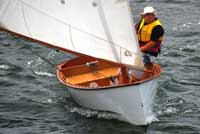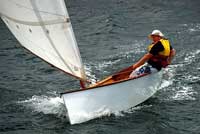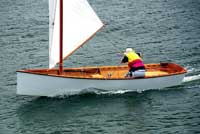| I've been up in Mooloolaba Queensland for around
a week now (Jan 2007).
The purpose of the trip has been to do some planning
and groundwork for the PDRacer
- a small cheap sailing boat that is easy to build
as well as revise some of my plansets using technology
I have available up here.
I'm staying with my Friends, Peter and Jo Hyndman
who built the first Goat
Island Skiff over 12 years ago.
They also live on the edge of the Mooloola River
- which makes it quite easy to take a break and go
for a sail.
Peter has been perching up on his balcony with his
new Nikon D80 Digital Camera while I put the sailing
skiff through its paces.
 |
Peter has been
perching up on his balcony with his new Nikon
D80 Digital Camera while I put the sailing skiff
through its paces. |
Some people think that GIS stands for Geographic
Information Systems - for us it means Goat Island
Skiff.
One of the big problems with photos of quick boats
is that as they make so little fuss as they travel
through the water that they don't look like they are
doing much. We will be rectifying that shortly with
some video clips so you'll be able to see just how
much ground the boat is covering.
Definitely a quick boat. Maybe it doesn't have the
top end of a modern racing boat, but it is not going
to be embarrassed by any non trapeze type on any point
of sail and most windstrengths.
The thing about the GIS is that it is constructed
like a modern boat out of a minimum number of pieces.
- 2 x sides
- 1 x bottom
- 3 x seat tops
- 4 x bulkheads to support the seats and create
the built in buoyancy tanks
- 1 x transom.
There is very little else.
The end result is that this traditional looking sailing
skiff is lighter than many racing boats. Peter's own
Gruff weighs in at a very light 127lbs (58kg)- not
bad for a boat a little under 16ft (4.8m) - a geographic
advantage of Australian and NZ boat design and construction.
And there is no ultra thin ply or difficult construction
used - it is all robust 1/4" (6mm) ply.
So in these pics you can see it in fast mode - and
also see just how pretty it is.
There is just no comparison between it and the Lumbering
Lumberyard Skiffs you see drawn up traditionally.
But I do sort of ruin things by wearing such an tragic
hat.
| I do sort of ruin
things by wearing such an tragic hat. |

|
If you look at the pics below and on Peter's own
GIS website you will be able
to see it carrying a bit of weight too. I've sailed
it with 4 adults in the boat (Actually it was Peter
and Jo, me and my ex Maz) for a daysail on Moreton
Bay with a picnic aboard - about 700lbs (310kg) of
crew and gear. Nice moderate sailing breeze - we covered
a lot of ground that day covering open water and skimming
over shallows. Peter's site has a great deal of general
GIS information as well.
 |
The thing about
the GIS is that it is constructed like a modern
boat out of a minimum number of pieces. |
Epoxy and Low Maintenance
An interesting thing is that you wouldn't think
that this was a 12 year old boat judging by the pics.
It has never been repainted or revarnished - the sail
and ropes have never been renewed. The loads on everything
are so light compared to a modern boat.
A testament to coating a boat with a good quality
boatbuilding epoxy system and then following it with
a quality paint system. It costs more in the first
place, but the boat and the owner don't miss (even
slightly) the extra maintenance that would have been
necessary if cheaper materials had been used - ie
the two or three major sandings back and repaintings
that would have been required if cheaper materials
were used.
There is a lot of information about use and advantages
of epoxy in my boatbuilding
FAQ. You don't necessarily need to use
epoxy to build this boat, but it does make the structure
terrifically strong and low maintenance.
| You wouldn't think
that this was a 12 year old boat judging by the
pics. It has never been repainted or revarnished
- the sail and ropes have never been renewed. |

|
The plans are highly detailed and have been full
revised as of Feb 2007 with more pics and drawings
and a clearer layout. One expansion are a series of
photos giving information about the different systems
of the boat - mainsheet/downhaul/halyard and position
and photos of the parts. I hope that this makes it
easier to find the few fittings required independent
of your geography.
Michael Storer Boat Design
Wooden Boat Plans
www.storerboatplans.com

|